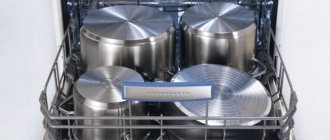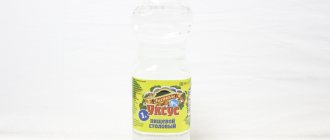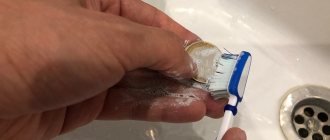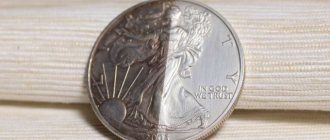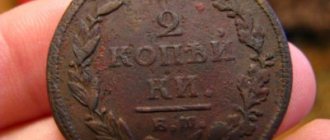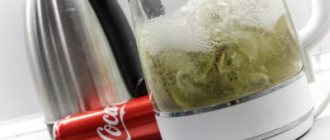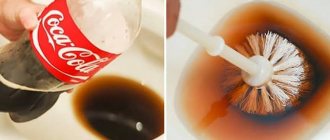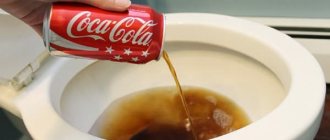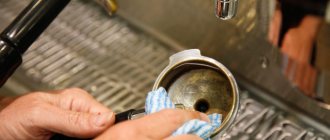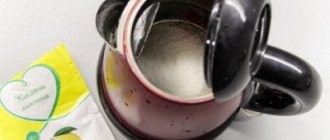10/29/201605/16/2017 Maria Ivanova
Cleaning coins at home is a simple set of works, the need for which is due to the oxidation of almost any metal over a certain period of time.
Those who know the specifics of various metals, in particular copper, gold, silver, etc., are aware of the fact that the older the coin, the more oxides appear on it.
When cleaning coins made of copper and other materials on your own, without turning to specialists, you need to follow simple rules to avoid causing damage to even the oldest coins.
Do we spend money on shopping or make do with what we have at hand?
Specialized solutions intended for cleaning procedures were developed taking into account the specifics of each specific metal: copper, silver, etc. Each of the products presented on the shelves of hardware stores allows you to remove various contaminants, uneven patina, and oxides from the surface of coins.
However, in an effort to restore copper and other metals to their original radiance and purity, not everyone can afford to purchase these rather expensive solutions.
Therefore, most ordinary consumers decide to tidy up the copper surface of coins using more accessible and less expensive means.
Alternative cleaning methods suitable for use at home can clean almost any dirty copper coin.
The list of necessary funds available in most households is as follows:
- "Coca Cola";
- lemon acid;
- soap;
- electrolysis.
With the help of each of them, many ordinary consumers were able to clean the copper surfaces of coins and other products made from this and other metals without unnecessary hassle.
The algorithm for cleaning coins made of copper and silver is characterized by the same simplicity and accessibility as for similar copper products. Numerous online resources contain all the necessary information.
The following review is devoted to the task of cleaning copper coins in various ways.
Cleaning coins with special means
Special household chemicals will help restore metal money to its original shine and purity. The products are available in the form of liquids or sprays and are effective, but require compliance with certain rules of use.
Cleaning algorithm:
- Read the instructions on the packaging and follow them carefully.
- Take the recommended safety measures - wear gloves, avoid contact of the product with skin or mucous membranes, and do not inhale fumes.
- Treat the fines with chemicals according to the instructions.
- After the set time has expired, rinse the product with water and dry.
Professional coin cleaners are highly effective and remove traces of corrosion, oxidation, and dirt in a few minutes.
The following products are especially popular: “Asidol-M”, Silbo, Leuchtturm, Shine Coins. With their help you can clean products made of gold, silver, copper, brass, bimetal . When choosing, consider the degree of contamination, the type of metal, and carefully read the instructions before use.
Citric acid for clean and shiny copper coins
The preparatory stage consists of searching and selecting a container, the possible material for which is:
- plastic;
- ceramics.
To clean copper coins, in addition to citric acid, you also need to prepare water. The acid is poured into a container and diluted with water. Coins are dropped into the solution.
It is necessary to take into account the fairly strong aggressiveness of the solution - the cleaning process must be carried out under continuous monitoring.
From time to time the product needs to be turned over. Carelessness and neglect of this requirement can lead to the fact that the solution can clean the coin right down to the metal.
After you have managed to clean the entire surface of the product, remove the contamination completely, it is advisable to create an artificial patina.
Cleaning with vinegar
Acetic acid, like any other, is suitable for cleaning copper coins. A limitation of its use is that this method damages the patina and exposes cavities and other irregularities in the field of the coin. For cleaning, use a solution of vinegar in water with a strength of 7-20% from any grocery store.
| These 10 flights from 1892 were immersed in acetic acid for 15 minutes, then brushed with a toothbrush. It is clearly noticeable that the patina on the coin is damaged in places and will need to be applied artificially, but the green oxides were quickly removed. |
How to clean quickly: 2 options with soap
Option #1
This cleaning method is considered to be as gentle and safe as possible for the item. As a rule, in this case, it is not household soap that is used, but neutral baby soap.
Having decided how to clean the coins, you must first grate the soap on a coarse or medium grater. Then the grated soap is diluted with a small amount of water until a homogeneous plastic mass is obtained.
To clean coins, they are inserted into the resulting soap mass. Having left the products in this state for some time, it is nevertheless necessary to periodically remove them from the water and check them, washing off layers of dirt and oxides.
Having decided to clean coins using this method, you need to understand such specifics of the approach as its impressive duration. The fact is that absolute cleansing in extreme cases can only be achieved after several weeks.
Option No. 2 (optional)
You can also achieve the desired goal by resorting to laundry soap. The process is somewhat different from the similar one described above, but it is also simple.
In this case, a plastic container is used as a container. It is filled with boiling water, into which soap shavings are poured.
After waiting for the soap to completely dissolve and obtain a jelly-like substance, the owner can dip copper coins into it, leaving it for a day or even two. The length of stay in the solution depends on the degree of contamination of the products.
After the required period of time has passed, the money must be washed using a soft brush and dried thoroughly.
Multiple repetitions of the procedure are allowed. By removing all the oxides layer by layer, you can get coins with an absolutely clean surface without any damage.
Effective methods, but dangerous
With these methods you will remove the most difficult stains. But if you make a mistake, you will probably damage the coin. Weigh all the risks before getting started.
Ammonia
Use this method on very dirty coins. Ammonia, also known as an alcohol solution of ammonia, is a fairly powerful solvent; it can easily remove the most durable plaque.
To remove dirt:
- Prepare a jar that can be closed with a lid.
- Pour ammonia there. The liquid level should be such as to cover the coin with a margin.
- Place the product in ammonia. Soon you will see that the liquid has turned green. Don't be alarmed, this is normal.
- Cover the jar with a lid to prevent the ammonia from evaporating.
- Soak the coin in ammonia for 5-10 minutes. It can be longer if there is really a lot of plaque. But be careful not to overdo it. You want to dissolve external contaminants without damaging the metal. The exposure time depends on the amount of plaque and dirt.
- When the product is cleaned, do not remove the coin under any circumstances! Place the jar under running water and keep it there until the ammonia rinses out.
- Take out the product, rinse, wipe.
If you are not satisfied with the result, repeat the procedure.
Ammonia is especially effective at removing copper oxide. They look like cherry red layers.
Important. Copper coated with ammonia should never come into contact with air. The metal will begin to oxidize and dark, untidy spots will appear on it. It is very difficult to remove them.
Vinegar and citric acid
Using vinegar will quickly clean your coins, but you risk ruining the coin. The acid will remove plaque and greens, but will open up all the irregularities and cavities on the metal.
Are you ready to take a risk? Then:
- Add 1 tbsp to 1 liter of water. l vinegar. Use regular store-bought 9% concentration.
- Place a coin in the vinegar solution.
- Hold for 5 minutes.
- Rinse and brush with a toothbrush.
If individual plaque fragments do not dissolve, but have softened, remove them with a pin or wooden toothpick. Wipe problem areas with a cotton swab dipped in an acidic solution. This way you will remove local contamination without damaging the already cleaned metal.
If you don't have vinegar, use citric acid. They are very similar in type of impact. Dissolve 1 tsp in 1 liter of water. acid and proceed according to the scheme described above.
Fizzy Coca-Cola: Spend Money to Clean
The ambiguous properties of the drink, beloved by children and adults, have also found their application in the struggle for the purity and shine of hard coins.
Many people already know that it can be used to perfectly clean and shine the chrome surfaces of various products. Cleaning antique coins at home is no less successful.
So, to clean a dirty and tarnished coin, you need to put it in a container, preferably glass, and fill it with a fizzy drink. The dishes and their contents are left in this state for several days, preferably a week.
If you lack patience, the time required to clean coins can be significantly reduced. To do this, the dishes are placed on a radiator or other safe and effective heat source. The essence of the approach is that increasing the temperature speeds up the reaction.
It is possible to tidy up an old coin using the presented method due to the content of a small amount of orthophosphoric acid in the sweet drink. If the contamination is much more serious, you will have to resort to more radical methods.
Regular toothpaste
The simplest and relatively safe way to clean 10 ruble coins is to use ordinary toothpaste
. Moreover, the cheapest brand New Pearl or Colgate without additives in the form of crystals will do. The brush should be soft and hard to reduce the likelihood of scratches, and be sure not to bend. Otherwise, the process will drag on for a long time.
2-3 drops of paste are enough for one coin. Cleaning should begin under running warm water or in a small saucer of heated bottled drinking water. Under the tap, in 90% of cases it is chlorinated, which can later affect the quality. Dozens of plated ones begin to shine immediately. On bimetallic coins, the rim first becomes light, then the central part.
This method is excellent for cleaning coins from blackness and small deposits. Does not protect against rust and corrosion. When stored in a capsule or album, the shine remains for 4-5 months.
Electrolysis method
Those who paid due attention to physics lessons are familiar with this concept from school. Its usefulness when processing coins will be ensured if the following two important rules are observed:
- compliance with safety regulations;
- testing the method on inexpensive items in order to avoid damage to more valuable products.
It is worth paying special attention to the second point of the operating principles: the fact is that sometimes, due to a minor mistake, serious, irreparable damage is caused to a coin or other valuable item.
Old coins are restored to their purity and shine through the use of a small power supply (6-12 Volts). As such, a universal charger can be used. Another alternative: an old mobile phone charger.
The following are attached to the power supply or its alternative:
- two alligator clips;
- some small metal object (not copper or brass is recommended);
- deep dishes made of glass or ceramics.
A saline solution is also used, prepared in compliance with the following proportions: 1 tablespoon of salt per 1 liter of water.
The process is simple, you just need to follow all the steps exactly. One clip - with a minus sign - is attached to the specimen, while the opposite one - with a plus sign - is attached to a metal object.
Then the coin and the metal product are lowered into a pre-prepared container where the saline solution is located, while the power supply is plugged into the outlet.
The result makes itself known quite quickly: the process of dissolving oxides and dirt leads to rapid clouding of the solution. The “bathing” period is short, after which the specimen is washed with hot water and dried.
A little care and precision in following all steps will allow you to achieve the desired results.
Organic oil
Collectors use petroleum jelly or glycerin, but really anything will do: highly purified vegetable oil, cosmetic oil, or Johnson's Baby oil.
- Pour oil into a container and place a coin in it.
- Wait a week or two.
- Clean the copper with a scraper.
In this way you will remove minor plaque and darkening.
If soaking gives poor results, boil the coins in oil. This method is effective for cleaning well-preserved but dirty items. If you boil a heavily damaged coin, you will dissolve not only the plaque, but also the top layer of copper along with the coinage.
The coin is dipped into boiling oil for 5-7 minutes. During this time, the plaque turns into a sticky dense mass. Remove it with a brush and soapy water.
Soon you will have black but pure copper in your hands. Advice. The vapors from the oil are very flammable. During boiling, the container with oil must be covered with a lid.
Mechanical cleaning
Mechanical cleaning is a special process for restoring coins in which the coin is not cleaned, but rather cut out or restored in a layer of oxides. For such a reading, the decisive factor is the experience and hard work of the master. The technology can be described very primitively as follows:
- The surface of the coin is desalted and cleaned of dried dirt in distilled water;
- All oxides, including loose ones, are strengthened by impregnating the surface in synthetic resin (paraloid B72);
- Using scrapers, cutters, brushes, and needles of varying hardness, the master removes from the surface everything that he considers unnecessary. By securing unstable areas, they do not fall through and can be aligned with the main field of the coin and no cavities remain. All work is performed under a microscope.
| These 4 kopecks from 1762 were cleaned by a professional using mechanical cleaning technology. The result is simply magnificent, but such processing of the coin took a very long time (2 months for this coin) and is only relevant for rare and valuable coins. |
Causes of pollution
While in circulation, modern coins lose their presentable appearance over time. There are many reasons for this:
- moisture. Sweat on hands, getting into water, air humidity. All this negatively affects coins. A chemical reaction occurs with the metal, it oxidizes;
- household chemicals, acids, chlorine;
- air pollution - smog from car exhausts and various units;
- coin turnover. Coins in circulation have to come into contact with various substances (oil, acid, salts) on the hands. Also, contact with a hard surface may leave damage on them.
On ancient coins, contamination occurs mainly from prolonged exposure to soil, water or other aggressive environments.
Storage recommendations
After carrying out the cleaning process, the products are thoroughly washed and wiped dry with a cotton cloth. Especially valuable coins should be kept away from temperature changes and the sun. They try to pick them up carefully, without leaving traces. They are usually stored in a coin box - an album with sheets divided into standard square pockets for the collection.
If the patina of ancient coins was not intentionally damaged during the cleaning process, it can be replaced with an artificial one. To do this, place the object in a liquid of 10% hyposulfite for a short time, and the patina is restored.
